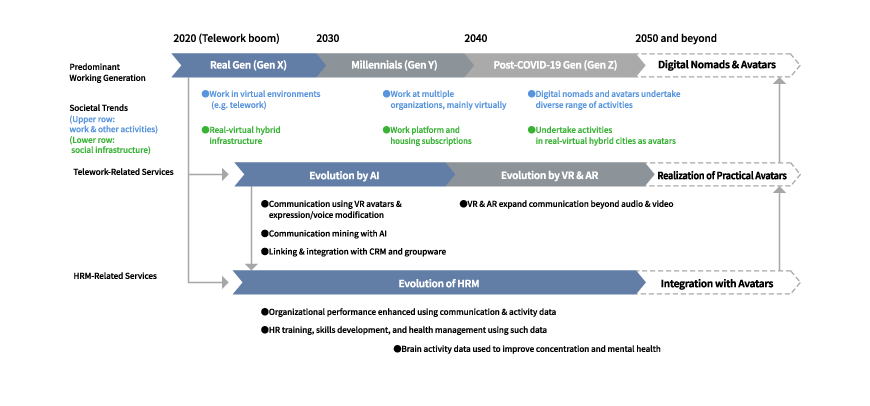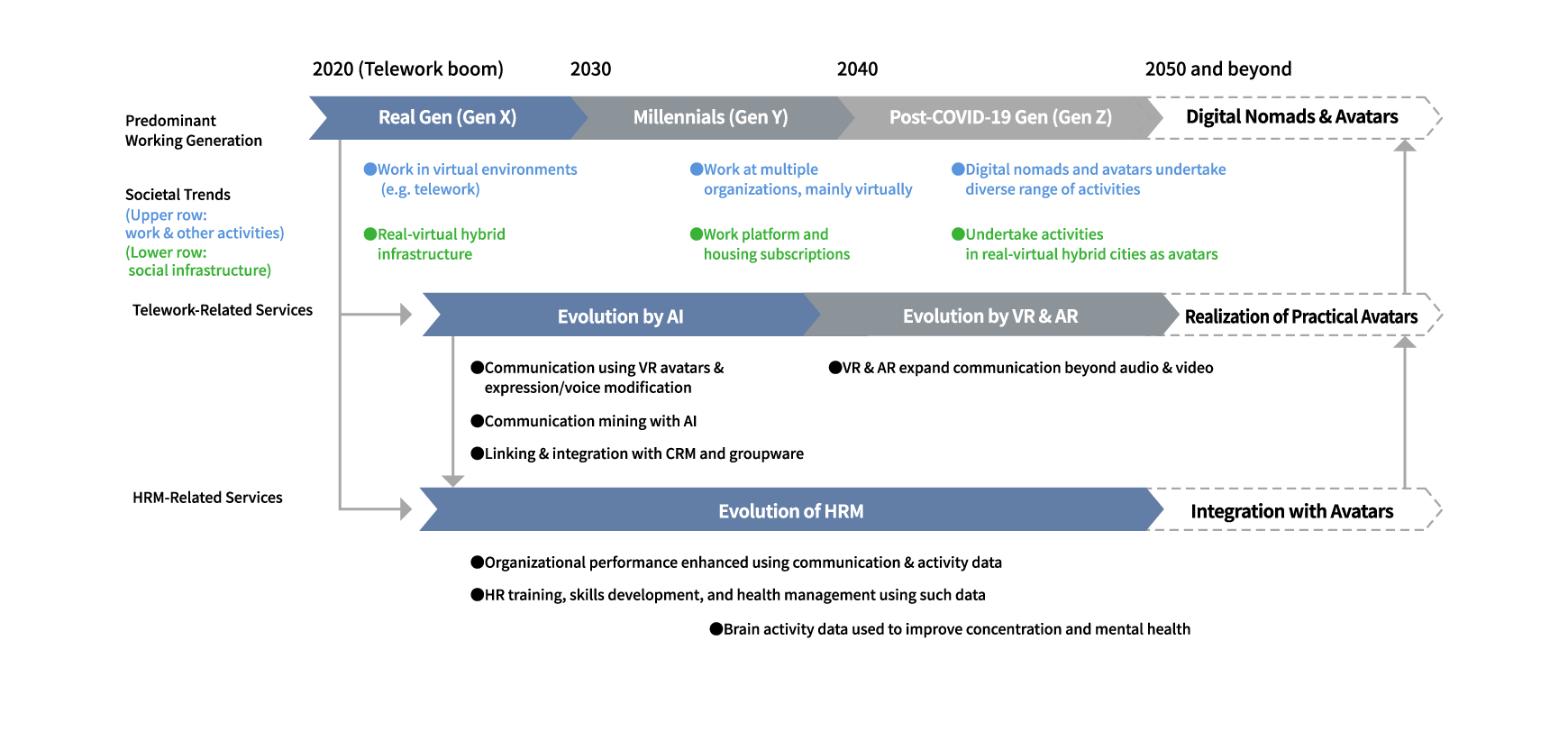
How Online Communication will Evolve in the Post-COVID-19 Era
Online Communication to Transform White Collar Work
Introduction
The COVID-19 pandemic has driven widespread change in the way people work. Such change is particularly notable among white-collar workers, many of whom have shifted to teleworking arrangements. On the business side, companies are analyzing the positives and negatives of telework, and many expect to continue or introduce at full scale telework arrangements even after the COVID-19 pandemic passes. Rollout is likely to take off in the years ahead for various technologies that make up for the disadvantages of telework (i.e. extending its advantages).
The following examines white collar work in the coming decades from the perspective of progress in telework-related services and progress in human resource management (HRM) services (Figure 1).
Evolution of Telework-Related Services
In the years ahead, the online communication tools that support telework will make dialogue more efficient by drawing on advances in speech recognition and natural language processing technologies. One possibility is an AI that understands what a given party is saying and suggests a list of appropriate responses. Advances in VR and AR, which create virtual worlds based on the real-world, will enable the efficient transmission of information that cannot be communicated through language or documents alone. Such telework services will likely enable performance levels surpassing those of face-to-face communication.
The following expands on future technology developments by time period.
2020s: AI-driven evolution of telework
In the 2020s, AI technology will be the primary driver of the telework evolution. More specifically, popularity will grow for communication and voice mining services that leverage AI technology.
In the customer service area, for example, such services will come to recommend possible answers to customer questions or automatically pull up information relevant to what a customer is talking about—all in real time.*1 In a sales setting, AI will be able to analyze the intentions or psychology behind customer dialogue and provide guidance to sales representatives. AI also has the potential to analyze conversation data from the entire sales team and provide tips for improving individual skills.
Telework will thus evolve as AI technology enables synergy between online communication tools, customer relationship management (CRM) systems, and groupware.
2030s and beyond: VR- & AR-driven evolution of telework
Starting in the 2030s, telework will further evolve with the expansion of VR and AR applications into areas of business activity that used to be conducted face-to-face. For example, services will arise that will make it possible for businesses to use the digital space as a venue to host factory tours or pitch a product. Sales staff will be able to talk about a product while a customer in a remote location has a simulated experience of the product using a head-mounted display and haptic gloves.*2
Evolution of HRM-Related Services
Online communication tools, among other technologies used in telework, provide useful data for improving the physical and mental wellbeing, boosting motivation, and develop skills of personnel. In the past, HRM consisted merely of having individual employees try their best to learn and grow, but moving forward HRM will evolve to function as a management activity based on scientific methods and that offers optimized programs for each employee.
Specific examples are provided below.
Services for improving organizational performance, training personnel, developing skills, and managing health
In the near future, services will gain particular prominence that use communication and activity data to enhance organizational performance, train personnel, develop skills, and manage physical and mental health. For example, new apps are emerging that visualize and measure employee happiness levels while simultaneously using the data to support management.*3
Services for improving concentration and mental health
As more and more work is carried out in digital spaces, problems will likely arise related to physical and mental health due to differences between work in the digital and real. To address this, companies are starting to look into services that use digital technologies to boost concentration or treat mental health conditions.
Research is underway for the application of earphones to monitor concentration and fatigue levels based on brainwave activity, and to create visualizations of the results.*4 Related research is investigating the use of role playing games (RPGs) in cognitive behavioral therapy† settings to treat depression.*5
† Cognitive behavioral therapy : a mental health therapy that encourages changes in thinking and behavioral habits
Key factors for Spread of Telework and HRM Services
Two factors are presented below that will be important for widespread adoption of telework- and HRM-related services. White collar workers could be freed from constraints in time and space by satisfying these key factors and expanding the use of telexistence services—thus accelerating fundamental changes in the way work is done.
Factor 1: Identifying proper instances for real world and online communication
The first factor requires the identification of the proper instances in which real world communication and online communication should respectively be used.
The telework boom has just begun, and there is much to learn about the positives and negatives of telework going forward. Infrastructural change will follow a shift in widespread conceptions of work and lifestyle due to the growing popularity of telework. For the effective use of new services, a common understanding must be developed with regard to the differences between business activities based on in-person communication versus those based on online communication. Concurrently, methods for mental and physical health management too require a baseline understanding on the differences between renditions through digital technologies versus in-person means.
Factor 2: Public receptivity to new services
The second factor concerns the receptivity of the general public to new HRM and telework services.
Certain telework services require collecting speech and other data from customers such as communication mining and voice mining. Such data use will require the development of society-wide rules on the collection of personal information.
Likewise, similar rules will need to be instituted for HRM-related services as the collection of personal information is required for measuring individual happiness levels and using digital technology to treat mental health conditions.
Societal Changes Resulting from Shift in Demographic Generations
Other than technology, societal transformation will also be driven by changes in the demographic generations that compose the workforce majority.
In the 2030s, millennials (people born in the 1980s to mid-1990s), which have a different workview than their predecessors, will compose the majority of the workforce. One survey showed that more than half of millennials answered that they plan to work for their current employer for "less than 2 years".*6 Dramatic change is imminent for styles of, values surrounding, and the very meaning of work.
In the 2040s, Generation Z (people born in the late 1990s and later), which experienced the COVID-19 crisis as children, will emerge as the predominant generation in the post-COVID era. Given their affinity to virtual worlds, this generation will likely accelerate a society-wide shift to online communication.
Two primary societal changes are detailed below that will occur as these generations trade places in the working population.
Change 1: Work styles and diverse activities
In the 2020s, work will increasingly shift to virtual spaces including telework. In the 2030s, individuals will begin to work at multiple organizations and undertake a diverse range of other activities, mainly virtually. In the 2040s and thereafter, the norm will shift to digital nomads and avatars working in various digital settings regardless of country of residence.
Change 2: Social infrastructure
Social infrastructure will transform alongside shifts in ways of working. Work styles are already gaining traction that combine the real and virtual in a hybrid form; this trend will continue in the 2020s with the rise of private office booths and the complete shift of administrative processes to the digital.
In the 2030s, subscription-service platforms will take hold in which individuals can work at multiple organizations and live in multiple locations.
In the 2040s and beyond, the structure of cities and organizations will be designed to match the activities of digital nomads and avatars; people, including digital nomads and avatars, will make use of real-virtual hybrid infrastructure of cities undertake their activities. Such a world will likely feature a very different definition and set of values concerning economic activity.
*1:NTT TechnoCross Corporation "ForeSight Voice Mining" (in Japanese)
https://www.ntt-tx.co.jp/products/
(Viewed on: 25 September 2020)
*2:NTT Communications Corporation "Virtual Reality Solutions: Utilizing VR in Sales" (in Japanese)
https://www.ntt.com/business/solutions/
(Viewed on: 25 September 2020)
*3:ITmedia NEWS "Hitachi to launch new company that visualizes employee 'happiness' and supports management with happiness measurement" (in Japanese)
https://www.itmedia.co.jp/news/articles/
(Viewed on: 25 September 2020)
*4:PR TIMES "University of Tokyo and VIE STYLE begin joint research on brain waves and AI: Joint research will use AI to support productivity by analyzing concentration and fatigue levels from earphone's 'VIE ZONE' brain wave measurements" (in Japanese)
https://prtimes.jp/main/html/rd/p/
(Viewed on: 14 October 2020)
*5:Nikkei XTECH "Using digital technology to treat mental health disorders: Why physicians are turning to games and VR" (in Japanese)
https://xtech.nikkei.com/atcl/nxt/column/18/01352/
(Viewed on: 25 September 2020)


